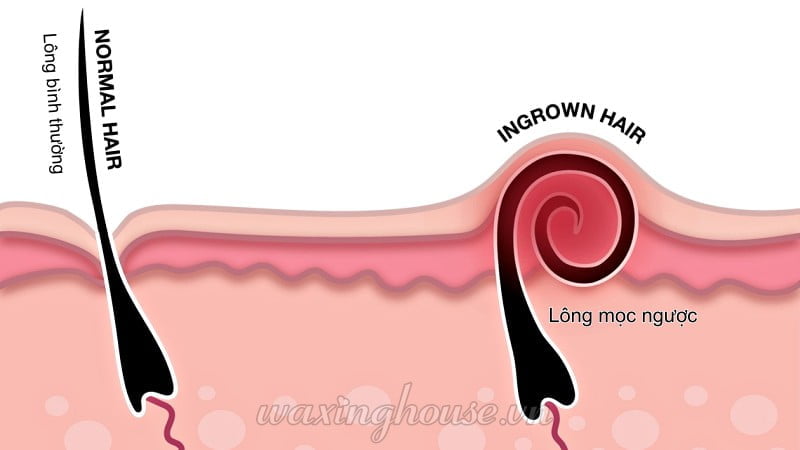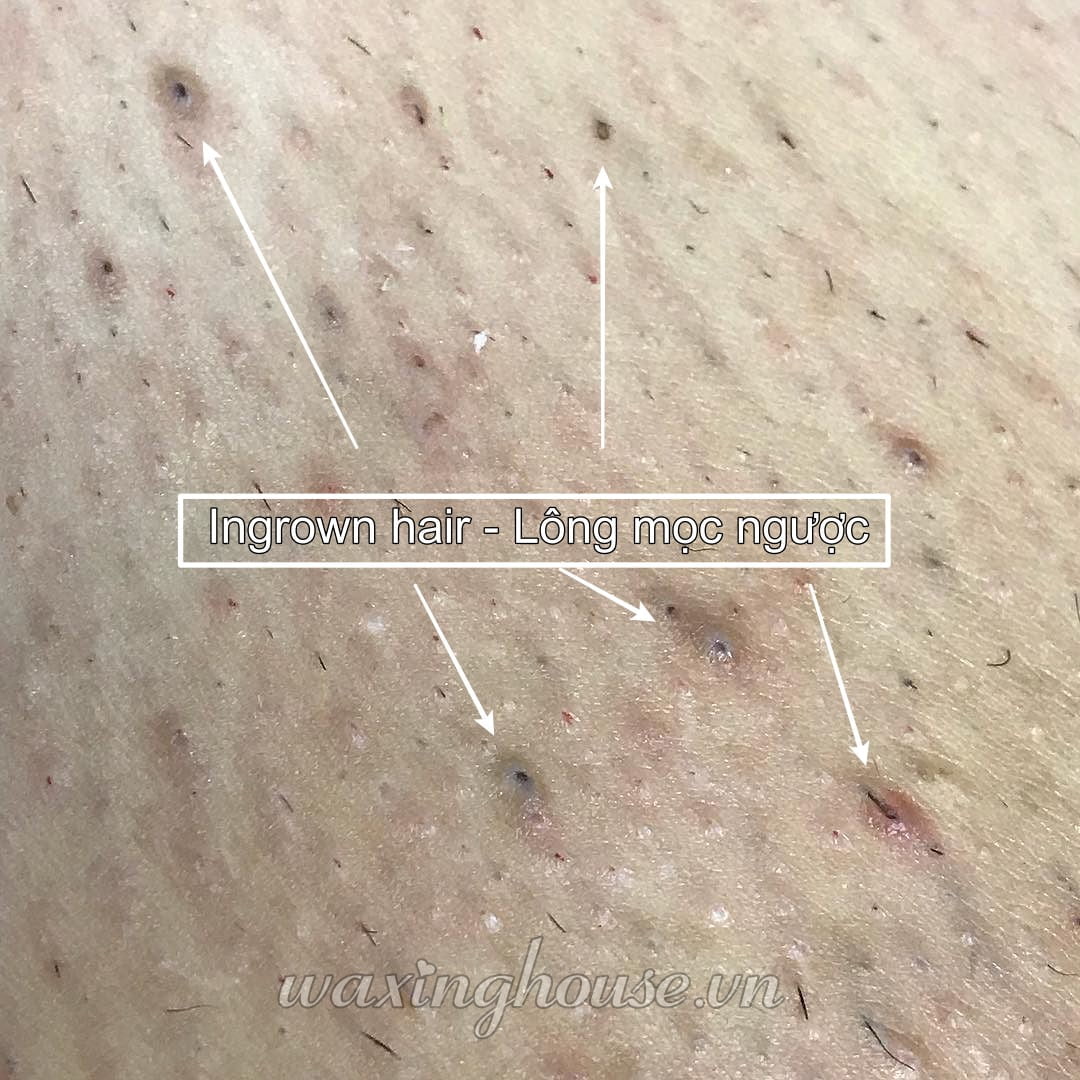This post is also available in:
![]() Tiếng Việt
Tiếng Việt
What is ingrown hair?

An ingrown hair is a hair that has grown back into the skin instead of growing out. This can happen after shaving, tweezing, or waxing, but it can also happen to people who don’t remove their hair. Ingrown hairs can be red, swollen, and painful, and they can sometimes lead to infection. It can happen anywhere on the body, but is most common in areas where hair is shaved or waxed, such as the legs, armpits, and bikini area.

Small bumps caused by ingrown hair are called papules

Small bumps caused by ingrown hair on the legHow would you know you have ingrown hair?
You can easily see there will be short hair curled up like small dark pimples. Or, hair growing inside the upper layer of skin in a downward stroke.

Ingrown hair at bikini area
Ingrown hair at bikini areaWhat are main causes of ingrown hair?
Ingrown hair can be caused by a variety of factors, including:
- Natural skin condition: Some people are more prone to ingrown hairs than others due to their genetics or skin type. For example, people with curly or coarse hair are more likely to experience ingrown hairs.
- Dead skin cells: Dead skin cells can build up and clog hair follicles, preventing hair from growing out properly. This can also cause the hair to grow back into the skin.
- Shaving, tweezing, or waxing: When you remove hair by shaving, tweezing, or incorrect waxing, you cut the hair shaft at an angle. This can cause the sharp tip of the hair to grow back into the skin, where it can become trapped and inflamed.
- Wearing tight clothes: Tight-fitting clothing can rub against the skin and irritate hair follicles, making it more likely for hair to grow back into the skin.
- Certain medications: Some medications, such as steroids and oral contraceptives, can increase hair growth and make you more likely to get ingrown hairs.
- Skin conditions: Certain skin conditions, such as eczema and psoriasis, can increase the risk of ingrown hairs.
- Hormones: Hormonal changes, such as those that occur during puberty or pregnancy, can also increase the risk of ingrown hairs.
How to treat ingrown hair?
There are various treatments for skin irritation and ingrown hairs. However, you should consult with skin professionals to find the best treatment for your case. The most common treatments are:
Use body exfoliation
Use a body scrub on a weekly basis to treat ingrown hair. Waxing House suggests you use body exfoliation 1 week after waxing. Don’t exfoliate your skin more than once a week.
Laser hair removal
Laser hair removal with high-quality machines will help to destroy the hair roots and improve the situation. This also has a beneficial effect on the inflammation and dark spots caused by ingrown hair.
Acne therapy
Laser hair removal does not work well for blonde and gray hair. Thus, people with those hair colors may not get the situation improved with laser hair removal. In this case, you can get an acne treatment. The beautician may pick the curled hair under the skin out, then apply acne serum and cream to calm down the skin.
How to prevent ingrown hair and dark spots?
Use a body scrub once a week
Normally, waxing removes the hair and skin dead cells at the same time. Thus, you will not need body scrub during the first week after waxing. It’s better you use exfoliation gel/cream without beads. Why? The beads in the scrub may make ingrown hair spots become dark spots. While applying the exfoliation, rub it in circular motions.
Do waxing correctly
It’s better to know how to perform waxing properly before you start to wax yourself. Improper waxing does not pull out all hair roots, resulting to ingrown hair.
If your skin type easily gets ingrown hair after waxing, it’s better you stop waxing and move to laser treatment.
Use a professional post-wax oil and lotion
When waxing the hair from any part of your body, make sure you follow up with profesional post-wax oil and lotion. These oils and lotions must be specialized for using after waxing, not normal products. Professional after-wax oil is able to remove the wax residue to prevent pore clogging. Besides, after-wax oil and lotion have a very light texture, anti-bacterial and calming functions. Keep using the lotion until hair starts growing back again. With soothing, anti-bacteria, and nourishing functions, after-wax lotion is good to use after laser hair removal as well.
Don’t use razors
Razors easily cause ingrown hairs. So, stop using razors. It’s better you choose another hair removal method such as waxing, laser hair removal.
Need consultation? Contact us!







